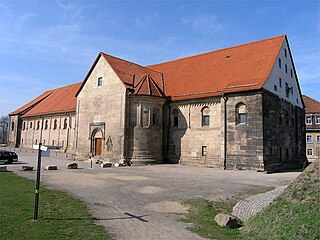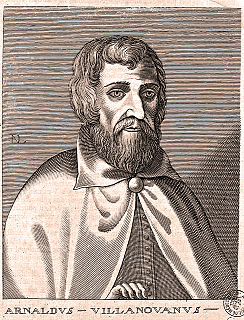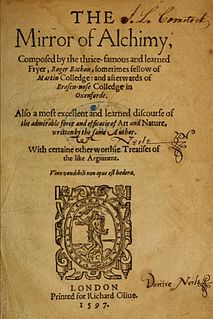
Alchemy is an ancient branch of natural philosophy, a philosophical and protoscientific tradition that was historically practiced in China, India, the Muslim world, and Europe. In its Western form, alchemy is first attested in a number of pseudepigraphical texts written in Greco-Roman Egypt during the first few centuries AD.

Basil Valentine is the Anglicised version of the name Basilius Valentinus, ostensibly a 15th-century alchemist, possibly Canon of the Benedictine Priory of Saint Peter in Erfurt, Germany but more likely a pseudonym used by one or several 16th-century German authors.

Pierre Eugène Marcellin Berthelot was a French chemist and Republican politician noted for the Thomsen–Berthelot principle of thermochemistry. He synthesized many organic compounds from inorganic substances, providing a large amount of counter-evidence to the theory of Jöns Jakob Berzelius that organic compounds required organisms in their synthesis. Berthelot was convinced that chemical synthesis would revolutionize the food industry by the year 2000, and that synthesized foods would replace farms and pastures. "Why not", he asked, "if it proved cheaper and better to make the same materials than to grow them?"

Castres is the sole subprefecture of the Tarn department in the Occitanie region in Southern France. It lies in the former province of Languedoc, although not in the former region of Languedoc-Roussillon. In 2018, the commune had a population of 41,795.

Castelnaudary is a commune in the Aude department in the Occitanie region of southern France. It is located in the former province of the Lauragais and famous for cassoulet of which it claims to be the world capital, and of which it is a major producer.

Arnaldus de Villa Nova was a physician and a religious reformer. He was also thought to be an alchemist. The fact that several renowned alchemists recognized him as an adept reinforces the thesis that he was an alchemist. He was also, like most wise men of his time, an astrologer.

Charles Adrien Casimir Barbier de Meynard, born at sea on a ship from Constantinople to Marseille, was a nineteenth-century French historian and orientalist.
Denis Zachaire (1510–1556) is the pseudonym of a 16th-century alchemist who spent his life and family fortune in a futile search for the Philosopher's Stone and the Elixir of Life.
Petrus Bonus was a late medieval alchemist. He is best known for his Precious Pearl or Precious New Pearl, an influential alchemical text composed sometime between 1330 and 1339. He was said to have been a physician at Ferrara in Italy, causing him to sometimes be known as Petrus Bonus of Ferrara or as Petrus Bonus the Lombard. An Introduction to the Divine Art is also attributed to him but was printed much later, in 1572.
John Dastin (c.1293-c.1386) was an English alchemist of the fourteenth century. Little is known of his life beyond the texts which are attributed to him. Dastin is known for correspondence with Pope John XXII and Cardinal Napoleone Orsini in defense of alchemical practice, dated to 1320.

Jean-Jacques Manget (1652–1742) was a Genevan physician and writer. He was known for his work on epidemic diseases such as bubonic plague and tuberculosis. In addition to his own researches, he assiduously compiled preceding medical literature. With Théophile Bonet, he is considered one of the "great compilers" of knowledge in the areas of medicine, surgery and pharmacology. He also published a major collection of alchemical works, the Bibliotheca Chemica Curiosa (1702).

Jean Perréal -- sometimes called Peréal, Johannes Parisienus or Jean De Paris -- was a successful portraitist for French Royalty in the first half of the 16th century, as well as an architect, sculptor and limner of illuminated manuscripts. He was active mostly in France and in Italy and London as well.
Pseudo-Democritus is the name used by scholars for a number of Greek writings which were falsely attributed to the pre-Socratic philosopher Democritus (c. 460–370 BC).

Robert Arnauld d’Andilly was a French conseiller d’État, specialising in financial questions, in the court of Marie de' Medici. By the elegance of his language, he was among the major poets, writers and translators of 17th century French classicism. A fervent Catholic, he played an important role in the history of Jansenism and was one of the Solitaires of Port-Royal-des-Champs. He was also renowned for his part in the development of the pruning of fruit trees, to which he was devoted.

Eugène Léon Canseliet, was a French writer and alchemist. He was a student of the mysterious alchemist known as Fulcanelli. He wrote the preface for each of his master's books. Later in his life after his master departed from this world, he took a quiet life in France and continued to study and practice what Fulcanelli taught him, even taking on students.
Bernard Gilles Penot was a French Renaissance alchemist and a friend of Nicolas Barnaud.
The Book of the Composition of Alchemy is generally considered to be the first translation of an Arabic work on alchemy into Latin, completed on 11 February 1144 by the English Arabist Robert of Chester. It contains a dialogue between the semi-legendary Byzantine monk Morienus and the Umayyad prince Khalid ibn Yazid. The popularity of the work among later alchemists is shown by the fact that it has been preserved in many manuscripts and that it has been printed and translated into vernacular languages several times since the sixteenth century.

The Mirror of Alchimy is a short alchemical manual, known in Latin as Speculum Alchemiae. Translated in 1597, it was only the second alchemical text printed in the English language. Long ascribed to Roger Bacon (1214-1294), the work is more likely the product of an anonymous author who wrote between the thirteenth and the fifteenth centuries.
Geneviève Hasenohr is a French philologist and prolific scholar of medieval and Renaissance French literature. She has authored or contributed to more than forty books, written at least fifty academic articles and reviews, and prepared numerous scholarly editions.
Émile Jules Grillot called Émile-Jules Grillot de Givry was a French Catholic man of letters and occultist, Freemason and pacifist, translator into French of numerous alchemical works including those of Paracelsus.














